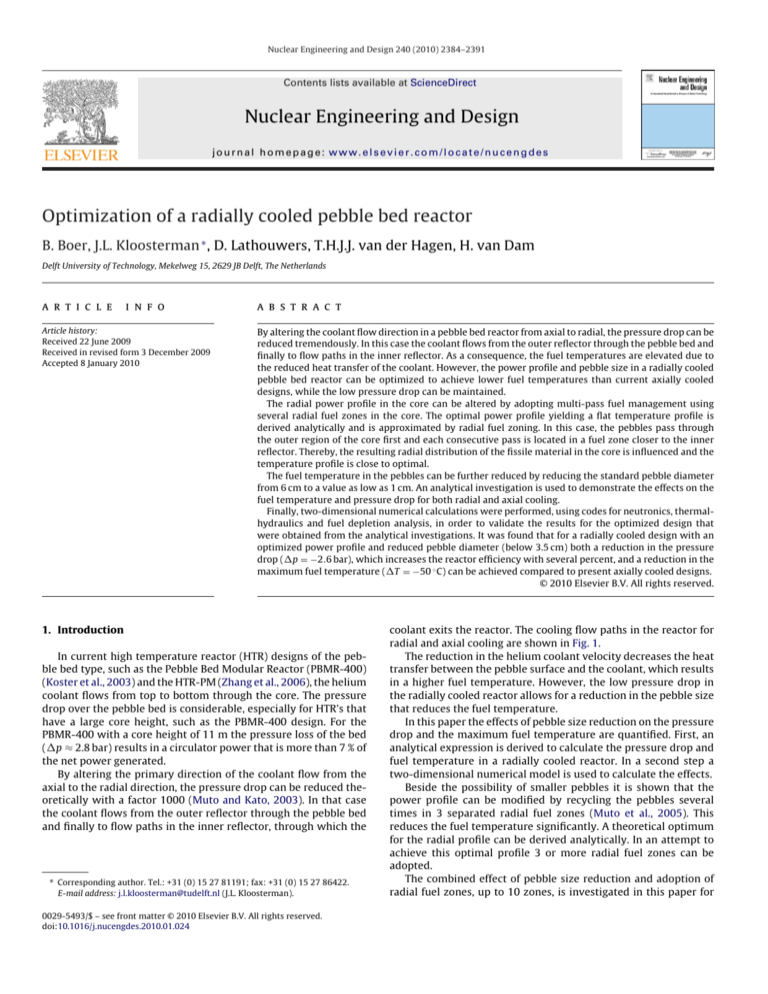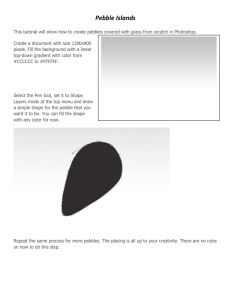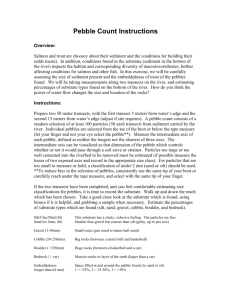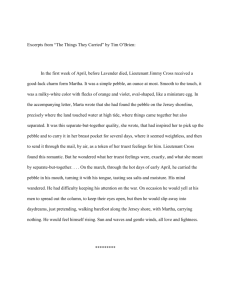
Nuclear Engineering and Design 240 (2010) 2384–2391
Contents lists available at ScienceDirect
Nuclear Engineering and Design
journal homepage: www.elsevier.com/locate/nucengdes
Optimization of a radially cooled pebble bed reactor
B. Boer, J.L. Kloosterman ∗ , D. Lathouwers, T.H.J.J. van der Hagen, H. van Dam
Delft University of Technology, Mekelweg 15, 2629 JB Delft, The Netherlands
a r t i c l e
i n f o
Article history:
Received 22 June 2009
Received in revised form 3 December 2009
Accepted 8 January 2010
a b s t r a c t
By altering the coolant flow direction in a pebble bed reactor from axial to radial, the pressure drop can be
reduced tremendously. In this case the coolant flows from the outer reflector through the pebble bed and
finally to flow paths in the inner reflector. As a consequence, the fuel temperatures are elevated due to
the reduced heat transfer of the coolant. However, the power profile and pebble size in a radially cooled
pebble bed reactor can be optimized to achieve lower fuel temperatures than current axially cooled
designs, while the low pressure drop can be maintained.
The radial power profile in the core can be altered by adopting multi-pass fuel management using
several radial fuel zones in the core. The optimal power profile yielding a flat temperature profile is
derived analytically and is approximated by radial fuel zoning. In this case, the pebbles pass through
the outer region of the core first and each consecutive pass is located in a fuel zone closer to the inner
reflector. Thereby, the resulting radial distribution of the fissile material in the core is influenced and the
temperature profile is close to optimal.
The fuel temperature in the pebbles can be further reduced by reducing the standard pebble diameter
from 6 cm to a value as low as 1 cm. An analytical investigation is used to demonstrate the effects on the
fuel temperature and pressure drop for both radial and axial cooling.
Finally, two-dimensional numerical calculations were performed, using codes for neutronics, thermalhydraulics and fuel depletion analysis, in order to validate the results for the optimized design that
were obtained from the analytical investigations. It was found that for a radially cooled design with an
optimized power profile and reduced pebble diameter (below 3.5 cm) both a reduction in the pressure
drop (p = −2.6 bar), which increases the reactor efficiency with several percent, and a reduction in the
maximum fuel temperature (T = −50 ◦ C) can be achieved compared to present axially cooled designs.
© 2010 Elsevier B.V. All rights reserved.
1. Introduction
In current high temperature reactor (HTR) designs of the pebble bed type, such as the Pebble Bed Modular Reactor (PBMR-400)
(Koster et al., 2003) and the HTR-PM (Zhang et al., 2006), the helium
coolant flows from top to bottom through the core. The pressure
drop over the pebble bed is considerable, especially for HTR’s that
have a large core height, such as the PBMR-400 design. For the
PBMR-400 with a core height of 11 m the pressure loss of the bed
(p ≈ 2.8 bar) results in a circulator power that is more than 7 % of
the net power generated.
By altering the primary direction of the coolant flow from the
axial to the radial direction, the pressure drop can be reduced theoretically with a factor 1000 (Muto and Kato, 2003). In that case
the coolant flows from the outer reflector through the pebble bed
and finally to flow paths in the inner reflector, through which the
∗ Corresponding author. Tel.: +31 (0) 15 27 81191; fax: +31 (0) 15 27 86422.
E-mail address: j.l.kloosterman@tudelft.nl (J.L. Kloosterman).
0029-5493/$ – see front matter © 2010 Elsevier B.V. All rights reserved.
doi:10.1016/j.nucengdes.2010.01.024
coolant exits the reactor. The cooling flow paths in the reactor for
radial and axial cooling are shown in Fig. 1.
The reduction in the helium coolant velocity decreases the heat
transfer between the pebble surface and the coolant, which results
in a higher fuel temperature. However, the low pressure drop in
the radially cooled reactor allows for a reduction in the pebble size
that reduces the fuel temperature.
In this paper the effects of pebble size reduction on the pressure
drop and the maximum fuel temperature are quantified. First, an
analytical expression is derived to calculate the pressure drop and
fuel temperature in a radially cooled reactor. In a second step a
two-dimensional numerical model is used to calculate the effects.
Beside the possibility of smaller pebbles it is shown that the
power profile can be modified by recycling the pebbles several
times in 3 separated radial fuel zones (Muto et al., 2005). This
reduces the fuel temperature significantly. A theoretical optimum
for the radial profile can be derived analytically. In an attempt to
achieve this optimal profile 3 or more radial fuel zones can be
adopted.
The combined effect of pebble size reduction and adoption of
radial fuel zones, up to 10 zones, is investigated in this paper for
B. Boer et al. / Nuclear Engineering and Design 240 (2010) 2384–2391
both normal and loss of forced cooling conditions (LOFC) using
existing codes and methods for neutronics, thermal-hydraulics and
fuel depletion analysis.
Nomenclature
cp
d
h
H
k
khe
P
Pr
q
r
i
o
Re
Rfuel
Rpeb
T
Tmax
v
p
ε
tot
helium thermal capacity (J/kg/K)
pebble diameter (m)
heat transfer coefficient (W/m2 /K)
core height (m)
pebble conductivity (W/m/K)
helium conductivity (W/m/K)
reactor power (W)
Prandtl number
power density (W/m3 )
radial position in the core (m)
inner
outer
Reynolds number
pebble fuel zone radius (m)
pebble radius (m)
helium temperature (K)
pebble center temperature (K)
helium velocity (m/s)
pressure difference (Pa)
pebble bed porosity
helium viscosity (m·s/kg)
total heat transfer coefficient
(W/m3 /K)
helium density (kg/m3 )
friction factor
2385
2. Optimization of the pebble size
In order to quantify the effect of the pebble diameter size on
the pressure drop and the fuel temperature a simple analytical
procedure is used first.
The maximum temperature at the pebble center, for a pebble
located at a radial position r in the core can be calculated from the
helium temperature T and the power density q with the following
equation (Kugeler and Schulten, 1989):
1 q (r).
tot
Tmax (r) = T (r) +
(1)
In the above equation (1/tot ) is the total thermal resistance
(multiplied with the volume) between helium coolant and pebble
center. An equation for the total thermal resistance can be derived
from a heat balance for a single pebble (Kugeler and Schulten,
1989), assuming that heat is generated in the fuel region of the
pebble only:
(volumetric)
1
1
=
(1 − ε)
tot
3
Rpeb
2kRfuel
−
2
Rpeb
3k
+
Rpeb
3h
.
(2)
The heat transfer coefficient h between the helium coolant and
the pebble surface can be calculated with (Kugeler and Schulten,
1989):
h=
khe
2Rpeb
1.27
Pr 0.33 0.36
Pr 0.5
Re
+ 0.033 1.07 Re0.86
1.18
ε
ε
.
(3)
The pressure difference by friction in a pebble bed depends on
the Reynolds number and is derived from the following relation
(Kugeler and Schulten, 1989):
∇p = −
=
1−ε 1 |v|v
ε 2Rpeb 2
320
6
.
+
1/10
(Re/(1 − ε))
(Re/(1 − ε))
(4)
(5)
and the Reynolds number is defined as:
Re =
2Rpeb ε|v|
.
(6)
For the axially cooled core a straightforward integration of Eq.
(4) over the core height results in a relation for the core pressure
drop. For the radially cooled core the velocity depends on the radial
position. From the continuity equation,
1 ∂(εr vr )
= 0,
r
∂r
(7)
it follows that
vr (r) =
ro vr (ro )
,
r
(8)
by assuming that the helium flows inward with a certain velocity
at the outer radius. It is assumed that the porosity profile of the
pebble bed is flat.
The momentum equation in cylindrical coordinates for the
radial direction is as follows:
εvr
Fig. 1. Flow paths in an axially (left) and radially (right) cooled pebble bed reactor.
∂vr
∂p
= −ε
+ε
∂r
∂r
1−ε 1 2
v .
ε 2Rpeb 2 r
(9)
Note that the constant porosity drops out of the above equation.
Combining Eq. (9) with Eqs. (4) through (6) and integrating over the
2386
B. Boer et al. / Nuclear Engineering and Design 240 (2010) 2384–2391
theoretically achievable. For example, Fig. 2 shows that compared
to the current PBMR-400 design the same temperature difference
can be achieved for a 1.8 cm pebble radius with a pressure drop a
factor 1000 lower (3 mbar).
3. Optimization of the power profile by radial fuel zoning
Besides reducing the pebble diameter, the power profile can also
be optimized in order to reduce the fuel temperatures.
First, an analytical approach is used to derive the optimal radial
power profile. In an attempt to realize this optimal profile the
(radial) starting positions of the pebbles are altered. In a second
step a more complex numerical calculation is used to determine
the resulting power profile for several pebble loading patterns.
3.1. Derivation of the optimal power profile in a radially cooled
reactor
Fig. 2. Pressure drop (p) over the core and temperature difference (T ) between
coolant and pebble center temperature for a radially (rad) and axially (ax) cooled
pebble bed, as a function of the pebble radius. The circle shows the operating conditions of the PBMR-400 design.
The differential energy equation in the radial direction for the
helium coolant, assuming that all the power generated is directly
transferred to the helium coolant, is (Bird et al., 2002):
cp εvr
radial direction results in the following expression for the pressure
difference:
p = (ro vr (ro ))2
2
(ro−2 − ri−2 )
−9/10
+ (ro vr (ro ))2 A · ln(ro /ri ) − B · (ro
−9/10
− ri
in which A and B are defined as follows:
2
A=
160(1 − ε) ,
ro vr (ro )ε2 d2
B=
10 (1 − ε)
3
εd
1−ε
ro vr (ro )εd
) ,
dT
= q (r)
dr
(12)
Demanding that the maximum temperature described by Eq.
(1) is constant over the radial direction of the core results in the
following equation:
(10)
1/10
(11)
Note that the first term in Eq. (10) represents the pressure difference by convective flow, which is small compared to the pressure
loss by friction for all cases considered.
The pressure and temperature have been calculated for various
pebble diameters for both an axially and a radially cooled pebble
bed based on the geometry of the PBMR-400 design. This design
has a core height of 1100 cm, an inner reflector with a radius of
100 cm and a pebble bed with an outer radius of 185 cm. The standard pebble has a radius of 3 cm with a fuel-free (graphite) outer
zone of 0.5 cm thickness. In the calculation for smaller pebble sizes,
the fuel-free zone of 0.5 cm is kept, while the fuel zone size is varied. A case with pebbles of 0.5 cm radius without graphite shell is
considered in Section 3.
The maximum temperature and pressure drop as a function of
the pebble diameter for both radially and axially cooled pebble
bed reactors are shown in Fig. 2. When radial cooling of the bed
is adopted instead of axial cooling, both the coolant velocity and
the length of the flow path through the core are reduced, which
results in a large reduction of the pressure drop over the core. The
reduction in coolant velocity causes a reduction in the heat transfer between coolant and pebble surface and therefore the pebble
center temperature increases (Fig. 2).
For a given pebble diameter the temperature difference is higher
for the radially cooled bed than for the axially cooled one. Reducing
the pebble diameter, in an attempt to reduce this temperature difference, leads to a high pressure drop for the axially cooled pebble
bed. In this case the pumping power is several percent of the power
generated. For the radially cooled pebble bed however, the pressure
drop remains small, even for very small pebble diameters. Therefore, by combining radial cooling with a reduced pebble size, a low
pressure drop together with lower fuel temperatures, compared to
an axially cooled core for a fixed helium outlet temperature, are
∂T
1 ∂q
+
=0
tot ∂r
∂r
(13)
By combining Eq. (12) with Eq. (13) and the previous result (Eq.
(8)) for vr we arrive at the following differential equation for the
radial power distribution:
∂q
+
∂r
tot
cp vr (ro )ro ε
rq (r) = 0
(14)
Solving Eq. (14) results in the following optimal power profile:
q (r) = Ae(−(1/2)(tot /cp vr (ro )ro ε)r
2)
(15)
in this equation A is a coefficient to be determined from the total
reactor power, P, using:
r0
2rHq (r)dr = P
(16)
ri
The resulting optimal power profile for a standard pebble size
(Rpeb = 3.0 cm) is presented in Fig. 3 and the resulting flat temperature profile in Fig. 4. A large difference exists between the
power level at the inner surface and outer surface of the pebble
bed. It follows from Eq. (15) that the profile depends on the total
heat transfer (Eq. (2)) and is more flattened for large pebble size.
In order to approximate the optimal power profile in practice the
radial distribution of the fuel has to be optimized.
3.2. Modified in-core pebble recycling scheme using radial fuel
zoning
The optimal power profile is approximated by dividing the core
into several radial fuel zones. A multi-pass recycling scheme is
adopted in which pebbles with a low burnup are placed in the outer
core region and high burnup pebbles in the inner region. In the case
that the total number of pebble passes through the core is larger
than the number of fuel regions, a fuel zone can contain pebbles
having different burnup levels.
Fig. 5 shows a pebble recycling scheme for a 3 zone core in which
pebbles pass through the core 10 times. The first pass of the pebbles
B. Boer et al. / Nuclear Engineering and Design 240 (2010) 2384–2391
2387
Fig. 3. The optimal (normalized) power profile yielding a radially flat temperature
profile (Rpeb = 3.0 cm) determined by an analytical derivation and two power profiles
obtained numerically by applying 3 and 10 radial fuel zones.
is in the outer fuel zone and each consecutive pass is either in the
same zone or in a zone closer to the inner reflector. Because fresh
fuel is now present on the outside of the core and depleted fuel
on the inside, the power level has increased on the outside and
decreased on the inside.
After each time a pebble has passed through the core the
burnup level is measured to determine its burnup level and consequent reloading position. The pebbles reach the target burnup of
95 MWd/kg after 10 passes.
3.3. Calculation procedure
The power profile for the proposed loading pattern is calculated
with a numerical procedure that is also used in the analysis of HTR
core optimization study (Boer et al., 2009). It consists of the coupled neutronics and thermal-hydraulics DALTON-THERMIX code
system (Boer et al., 2010) which is linked to the depletion analysis and neutron cross-section generation routines of the SCALE-5
code system (SCALE-5, 2005). The codes are used consecutively
until convergence is reached on the discharge burnup, neutron flux
and keff .
Fig. 4. The optimal fuel temperature profile (Rpeb = 3.0 cm) determined by an analytical derivation and two power profiles obtained numerically by applying 3 and
10 radial fuel zones.
Fig. 5. Pebble loading pattern for a core with 3 radial fuel zones and 10 pebble
passes, showing how the pebbles are recycled from the outside to the inside.
Several modules of the SCALE-5 are used to take into account
the double heterogeneity of the fuel (TRISO and pebble) and the
geometry of the reactor. The calculation steps are as follows:
1. First, the TRISO particles in the graphite matrix are modeled by
using the CSASIX module of SCALE-5. In this module the evaluation of the resolved and unresolved resonances which are treated
by the Nordheim Integral Method and the Bondarenko method,
respectively. A one-dimensional discrete ordinates transport
calculation is made of a fuel kernel surrounded by cladding
(material from the carbon buffer, IPyC, SiC and OPyC layers) and
moderator (graphite) material (see Fig. 6). The moderator volume having radius R0 is equal to the volume of the fuel zone of
the pebble divided by the number of TRISO’s. From this last calculation homogenized neutron cross-sections are made for “TRISO
material”. For this purpose a 172 energy group (XMAS) library is
used, based on the JEFF2.2/3.0 and JENDL3.3 libraries and pro-
Fig. 6. TRISO and Pebble model used in calculation of homogenized cross-sections
for the pebble bed region.
2388
B. Boer et al. / Nuclear Engineering and Design 240 (2010) 2384–2391
Fig. 7. Power profiles [MW/m3 ] for both 3 (left) and 10 (right) radial fuel zones.
Fig. 8. Fuel temperature profiles [◦ C] in a core with 3 (left) and 10 (right) radial fuel zones for a pebble radius of 3.0 cm.
B. Boer et al. / Nuclear Engineering and Design 240 (2010) 2384–2391
2389
Fig. 9. Fuel temperature profiles [◦ C] in a core with 3 (left) and 10 (right) radial fuel zones for a pebble radius of 0.5 cm.
cessed with NJOY. To account for the fuel-shadowing effect of the
fuel kernels in the graphite matrix of the pebbles a Dancoff factor
is used, which is analytically determined Bende et al. (1999) and
is a function of the number of fuel particles and the radii of the
kernel, the fuel zone and the pebble.
2. The homogenized neutron cross-sections for the TRISO material
are used in a one-dimensional transport calculation in which
a sphere of TRISO material, with radius R1 , is surrounded by a
layer of graphite and helium with radius R2 (see Fig. 6). In this
calculation R1 is equal to the fuel zone in the pebble and R2 =
3
3 /ε.
Rpeb
This transport calculation results in homogenized crosssections for “pebble bed material”.
3. As a last calculation step several one-dimensional transport calculations, representing a certain axial or radial cross-section of
the core, are performed. In general the geometry consists of
a pebble bed region surrounded by graphite reflector regions.
These regions are split up into several zones to generate zone
weighted few group cross-sections. In order to model the transverse neutron leakage in these 1D calculations the reactor height
(or width) is supplied from which a buckling factor is derived.
The zone weighted cross-sections of these 1D calculations are
allocated to the positions of the corresponding material in the
2D cross-section map.
The above described procedure is repeated for several fuel and
moderator temperatures resulting in a 2D temperature dependent cross-section library. Temperature feedback is taken into
account by performing several iterations between DALTON and
THERMIX.
A procedure to directly determine the equilibrium core composition is used (Boer et al., 2009), which consists of several iterations
between DALTON, SCALE and ORIGEN (SCALE-5, 2005).
3.4. Results of the modified in-core pebble recycling schemes
The resulting power profiles for 3 and 10 radial zones are presented in Fig. 7. In the case that 10 radial zones are used, each
zone represents 1 pebble pass, while for 3 radial zones, the pebbles pass through the inner and outer zone 3 times and 4 times in
the middle zone (Fig. 5). The profile for the 10 zone case shows a
smooth surface, while the 3 zone case exhibits two jumps at positions of the fuel region interfaces. In Fig. 3 the radially averaged
power profiles of the two numerical solutions are compared with
the optimal radial profile. The corresponding 1D temperature profiles, calculated with Eq. (1), are presented in Fig. 4. It can be seen
that the discontinuities vanish in the power profile when 10 zones,
instead of 3, are adopted. However, the profile does not significantly
improve with respect to the difference with the optimal profile.
The effect of the power profile, calculated with THERMIX (Struth,
1995), on the 2D pebble center temperature profile can be seen in
Figs. 8 and 9. In the case of 3 radial fuel zones and a pebble radius
of 3 cm, three peaks in the temperature profile can be identified
that correspond with the peaks in the power profile. If the number of fuel zones is increased to 10 and the pebble radius reduced
to 0.5 cm only one peak in the temperature profile remains, which
is located next to the inner reflector. The difference in the temperature between the outside and inside of the core is larger for
the smaller pebble size. This results from a reduction in the overall
thermal resistance (see Eq. (15)). It is noted that the average (and
maximum) temperatures in the cores with the small pebbles are
lower as compared to the reference.
4. Results of modified in-core pebble recycling in
combination with small pebbles
The combined effect of pebble size reduction and the fuel
management scheme on the pressure loss and maximum fuel tem-
2390
B. Boer et al. / Nuclear Engineering and Design 240 (2010) 2384–2391
Fig. 10. Effect of pebble size on the maximum fuel temperature for a radially cooled
reactor calculated with THERMIX for a core with 1, 3 or 10 radial fuel zones.
Fig. 11. Effect of pebble size on the pressure drop in the core (pebble bed and
reflector flow paths) calculated with THERMIX for a core with 1, 3 or 10 radial fuel
zones.
perature has been investigated with a two-dimensional reactor
model in the thermal-hydraulics code THERMIX (Struth, 1995) for
normal and LOFC conditions.
the pressurized case. In both cases the mass flow is reduced to zero
in the same time period.
In Fig. 12 the results for maximum and average temperature
during the DLOFC and PLOFC transients are shown.
The initial temperature profile for the transients can be seen in
Fig. 9 and the initial maximum and average temperatures in Fig. 12
are 939 and 753 ◦ C, respectively. In the first few hundred seconds
of the transients the maximum fuel temperature reduces quickly
since the fission power reduces quickly and the total reactor power
consists only of the decay heat. In the following hours, the maximum and average temperature of the pebble bed rise for both the
DLOFC and PLOFC cases. The natural circulation in the PLOFC case
distributes the heat over the entire core and to the inner reflector.
This heat transfer mechanism is absent in the DLOFC case and since
the heat is mostly generated in the outer region of the core (see
Fig. 3), the highest temperature is located in this region, while for
the PLOFC case the highest temperature occurs at the inner region
of the core. The heat of the reactor is removed through conduction
in the outer reflector and finally through convection and radiation
on the outside of the reactor pressure vessel. Therefore, the heat
is more effectively removed in the DLOFC case. The temperature
profiles for both cases at the time point of the maximum fuel tem-
4.1. Normal operating conditions
For the normal operating conditions, three different power profiles are used in the analysis. The first case represents a core
configuration without radial fuel zoning (1 zone), while in the two
other cases, the power profiles calculated in Section 3.2 for 3 and
10 radial zones are used. In all cases a total of 10 pebble passes is
used and the pebble radius is varied between 0.5 and 3.0 cm.
The maximum fuel temperature for the normal operating conditions as a function of the pebble radius for several pebble radii is
presented in Fig. 10. Both the use of more fuel zones and a reduction
of the pebble size result in considerably lower fuel temperatures. It
is noted that the adoption of the radial fuel zones is advantageous
during DLOFC conditions, since a larger part of the decay heat is
generated closer to the heat sink at the outer surface of the reactor
pressure vessel.
The average pressure drop over the pebble bed calculated with
THERMIX for a 3.0 cm pebble radius was found to be 2.1×10−3 bar,
which compares well with the 2.0×10−3 bar that resulted from the
analytical calculation. The THERMIX calculation shows that less
than 2 % of the total pressure drop occurs in the pebble bed for
this case, while the main part is caused by the pressure drop at the
slits and flow paths in the inner reflector. The total pressure drop
in the core as a function of the pebble radius is shown in Fig. 11.
Although the pressure drop increases with a reduction of the pebble
size it remains more than an order of magnitude smaller compared
to the axially cooled pebble bed for all cases.
4.2. LOFC conditions
The maximum and average fuel temperatures are calculated
for both a Pressurized and Depressurized Loss of Forced Cooling
(DLOFC and PLOFC) accident for a core with 10 fuel zones and Rpeb
= 0.5 cm.
It is assumed that a reactor SCRAM is performed at the beginning
of the transients and that the outer surface of the pressure vessel is
cooled effectively by the decay heat removal system, which is simulated by a fixed temperature and heat transfer coefficient. Adiabatic
boundary conditions are assumed for the top and bottom of the
model. During the first 13 s of the transients the system pressure is
reduced from 90 to 1 bar in the depressurized case and to 60 bar in
Fig. 12. Maximum (max) and average (ave) fuel temperatures during a pressurized
(plofc) and depressurized loss of cooling (dlofc) situation for a 10 zone core with
Rpeb = 0.5 cm.
B. Boer et al. / Nuclear Engineering and Design 240 (2010) 2384–2391
2391
size and altering the (re)fueling scheme of the reactor this temperature can be reduced to 50 ◦ C below the reference temperature,
while maintaining the low pressure drop. This would result in a
reduction of the pumping power with several percent of the generator power.
By recycling the pebbles from the outside of the core to the
inside the analytically derived optimal temperature profile can be
approximated by adopting 3 or more radial fuel zones. For a standard pebble the improved power profile results in a decrease of the
maximum fuel temperature with 125 ◦ C.
The optimized power profile is also advantageous during LOFC
accidents since the peak is located at the outer zone of the pebble
bed and the decay heat is removed more easily to the environment.
In both PLOFC and DLOFC transient cases, the maximum fuel temperature remains below that of the axial cooled design (1594 ◦ C).
This allows for an increase in reactor power (helium outlet temperature).
In the PLOFC transient the natural circulation of the helium
between pebble bed and flow paths in the inner reflector causes
higher temperatures in the pebble bed after several hours compared to the DLOFC transient. Further investigation on the influence
of the geometry of the flow paths and slits in the inner reflector on
these natural circulation flows is recommended.
In contrast with the large pressure drop over the pebble bed in
an axially cooled design, the total pressure drop in a radially cooled
design is determined by losses in the coolant flow paths in the inner
and outer reflector. Further research on the effect of the geometry
of the flow paths on the pressure drop is recommended.
Acknowledgements
Fig. 13. Temperature profiles [◦ C] during DLOFC (left) and PLOFC (right) transients
at the time of the maximum fuel temperature.
perature is presented in Fig. 13 to illustrate the above described
effects.
The maximum fuel temperature for the PBMR-400 design using
6 pebble passes and an axial coolant flow was calculated to be 1594 ◦
C and no radial fuel zoning. It can be seen that the temperatures
for the DLOFC and PLOFC cases for the radially cooled design are
significantly lower.
The transient temperature history for pebbles larger than a
0.5 cm radius is similar to that of Fig. 12, since the reactor power
during the transients is determined by the decay heat, which is
small compared to the fission power during normal operation.
Therefore, the difference in temperature between surface and center of the pebble is in the order of several Kelvin. It is noted that
reduced DLOFC peak temperatures can be achieved (Boer et al.,
2009) in an axial cooled PBMR design with radial fuel zoning (2
or 3 zones). However, this design does not benefit from the low
core pressure drop of the radially cooled design.
5. Conclusion
By altering the coolant flow from axial to radial direction, the
pressure drop in the pebble bed can be reduced from 2.8 to 0.002 bar
for a standard pebble size (Rpeb = 3.0 cm). The core average pebble
center temperature increases with 100 ◦ C. By reducing the pebble
This investigation has been conducted in the framework of the
RAPHAEL project (FI6O 516508,WP-SI2).
The authors would also like to thank NRG for their support in
the presented work.
References
Bende, E.E., Hogenbirk, A.H., Kloosterman, J.L., van Dam, H., 1999. Analytical
calculation of the average danco factor for a fuel kernel in a pebble bed hightemperature reactor. Nuclear Science and Engineering 133 (2), 147–162.
Bird, R., Stewart, W., Lightfoot, E., 2002. Transport Phenomena, 2nd ed. Wiley.
Boer, B., Kloosterman, J.L., Lathouwers, D., van der Hagen, T.H.J.J., 2009. In-core fuel
management optimization of pebble-bed reactors. Annals of Nuclear Energy 36
(8), 1049–1058.
Boer, B., Lathouwers, D., Kloosterman, J.L., van der Hagen, T.H.J.J., Strydom, G., 2010.
Validation of the DALTON-THERMIX code system with transient analyses of the
HTR-10 and application to the PBMR. Nuclear Technology 170.
Koster, A., Matzner, H., Nicholsi, D., 2003. PBMR design for the future. Nuclear Engineering and Design 222, 231–245.
Kugeler, K., Schulten, R., 1989. Hochtemperaturreaktortechnik. Springer.
Muto, Y., Kato, Y., 2003. A new pebble bed core concept with low pressure drop. In:
Transactions of the Global 2003 Conference, pp. 1202–1209.
Muto, Y., Kato, Y., Udagawa, R., 2005. Improvement of fuel temperature characteristics in a pebble bed core with horizontal flow by means of fuel zoning. In: In
Proceedings of ICAPP’05, Seoul, Korea.
SCALE-5, 2005. Modular Code System for Performing Standardized Computer
Analysis for Licensing Evaluations. Oak Ridge National Laboratory, Tennessee,
USA.
Struth, S., 1995. Thermix-Direkt: Ein Rechenprogramm zur instationären zweidimensionalen Simulation thermohydraulischer Transienten. FZ Jülich, Germany.
Zhang, Z., Wu, Z., Li, F., 2006. Design aspects of the Chinese modular hightemperature gas-cooled reactor HTR-PM. Nuclear Engineering and Design 236,
485–490.







